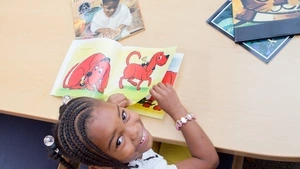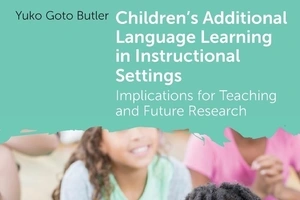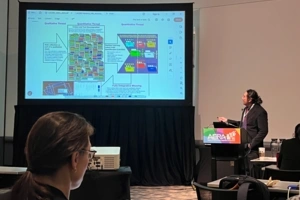Literacy is more than just reading.
Developing literacy, especially in young children, also means helping a child learn to engage with the world: How to ask questions, form knowledge, imagine the (im)possible, and reflect on their experiences.
With many young children spending more time at home due to COVID-19, Penn GSE Reading/Writing/Literacy doctoral student Daris McInnis offers these 14 activities that will help parents build these literacy skills with their children and have fun in the process.
These activities are all meant to be personalized to work with what you have at home or around your neighborhood.
Two ideas are at the heart of every activity.
The first is inquiry. One of the best ways to teach children is to ask a child questions, McInnis says, and to encourage a child to ask questions when they are curious or want to explore more.
The second is respect. It’s important we treat kids as the cosmopolitan intellectuals that they are, as Penn GSE’s Gerald Campano and Columbia professor Maria Paula Ghiso remind us. When we treat their ideas and questions with respect and engage them in meaningful dialogue, children will want to explore more.
Create a schedule
One of the first things kids see when they walk into a classroom is a schedule with pictures of what they will do for the day. Whether you are providing care for your child every day or only occasionally, a schedule can help orient both you and your child.
You can ask your child to draw pictures for each activity, which gives them some ownership over the schedule.
Remember, you can be flexible after you write in those times. Some activities will be shorter, some will take longer. That’s fine.
Looking for more advice for families? Subscribe to the Educator’s Playbook for Parents.
Chart the weather
Start the day by stepping outside and asking: what does it feel like and what does it look like?
Creating a meteorology chart to track the temperature and the forecast allows children to use their knowledge, senses, and curiosity to explore the weather and its effects.
Invite your child to draw the day’s forecast or weather. Or if this is an everyday activity, they could create a series of drawings representing different forecasts to swap in and out of your chart.
For slightly older children, around age 5 and 6, you can ask ‘why’ questions, like: why do you think it’s hot today? You can start to explain bigger concepts like the relationship between the sun and the earth and how seasons work, depending on your geography.
Tune up fine motor skills
Young kids love sorting things. With your child’s help, you can create a sorting activity that will help them notice similarities and differences and also develop their fine motor skills.
Collect objects from around your home of different size or shape, like a grain of rice, a bead, or a remote control. Ask your child to sort the objects into different piles. You are introducing the math concept of categorization and opening the door for powerful inquiry.
Ask the child why they put the grain of rice into this pile instead of that pile. Are they organizing by size, shape, color, or something else?
While they are thinking, you’ll be helping your child build their dexterity while they practice gripping with their thumb, index, and middle finger – this is important for pencil grip and writing activities in the future.
If a child is physically unable to sort the items without assistance, you can move the objects for them and still ask the rationale behind their choices.
Scavenger hunt!
You don't have to buy any new stuff to use your home as a play space.
When you create your scavenger hunt, you can show your child what a list is and why we would use one. You can ask them to find something that is a circle or a triangle. Find a letter S. Find a clock. Find something with the color green. The possibilities are limitless.
For slightly older kids, you can let your child do the hunt themselves and give them a time limit. Be sure to use a timer they can see, to keep them on task.
This is a way to encourage your child to notice details in their everyday environment and also build their vocabulary. For example, your child might identify an iron as a triangle. This is a chance to explain what an iron is and why someone would use it.
Bonus idea: Create some cutouts of letters and hide them around your home.
Plant a seed
You can create a really nice gardening activity with materials you have around the home, like reusing an egg carton, paper cups, or an old two-liter bottle.
You can show a child how to plant a seed. You can tell them about watering and sunlight needs. Have them start a plant journal where they can draw what they notice about the plant bed every day. This can open a conversation about the life cycle of the plant.
There’s even a behavior element to this lesson. How do we use our bodies around the plant? For instance, it’s probably not a good idea to play with or throw an object near the plant, because we might knock it over and hurt it.
Read aloud
Kids are innately brilliant, and books are a way to spark a child’s imagination and develop early literacy skills. As you are reading the book, make sure the child can see the pictures. Ask them what they notice, in both the narrative and the pictures, especially about details like characters’ facial expressions.
When you finish the story, encourage them to respond to the text. Maybe that’s drawing a picture of their favorite part. Or asking them to explain why they like or dislike a particular character in the story. You are providing opportunities for your child to explore their own ideas, extract information, form opinions, and infer.
Don’t forget, many libraries have created touchless pickup or have digital borrowing options to help families through COVID.
Readers’ theater
Building on a read aloud, have your child act out a favorite story, or act it out with them. For slightly older children, encourage them to make a costume from items around your home.
You are testing their comprehension, but it’s also super cute. If you’re able to, record their production on a mobile device, and let them see themselves as a writer, actor, and director.
Remember: Cardboard boxes make great set pieces, like vehicles or clubhouses.
Make some goo
Find a recipe online to make your own version of Gak or Play-Doh. It might be a good idea to try this activity on your own first. When you do get to the lab together (probably the kitchen area), start by going over the safety rules, and orient them to the materials and the ingredients.
Once your Gak or Play-Doh is ready, create letters and numbers on a piece of cardboard or tin. Have your child shape the material into the letters. This helps kids recognize their name, which they will need to do at day care or pre-school.
Added bonus: Because it can take 30 minutes to an hour just to make the material, this can be good for a rainy day spent inside.
Collage time
Collages are a great way to introduce kids to creating art. They can be figurative or abstract, and they can feature letters, shapes, colors, story characters, or any other theme you and your child might want to try. Found objects like bottle caps, pipe cleaners, and feathers make great additions — but think twice before opening glitter.
Don’t forget to ask your child to sign their piece, since they are, in fact, the artist. Then display it. Running out of gallery space? Try a memory board, which will let you slide pieces in and out. Save special pieces in a scrap book or an accordion file, which makes a meaningful gift when your child reaches a milestone like graduating high school.
When we treat their ideas and questions with respect and engage them in meaningful dialogue, children will want to explore more.
Take a virtual tour
Because of the pandemic, many museums and zoos around the world have expanded their virtual offerings.
Virtual tours are fun activities themselves, but they also offer another chance to invite your child to do some critical thinking. Say you tour the Smithsonian’s Air & Space Museum. You might learn that in our solar system, Mercury is the closest planet to the sun, but Venus is the hottest. Ask your child: why do they think this the case? You can explore comets or share dialogue about how gravity might work on other planets.
Inquiry is a great way to keep your child interested and engaged in learning, based on what they already know and things they care about, McInnis says. The discussion and exchange you have about what they learned, or what they liked, or what they want to know more about, can help you plan your next virtual tour.
Give them an apron
You can do two things at once: Engage your kids AND keep them busy while you prepare a meal.
If your family has a particularly cherished recipe you can tell you child how it’s been passed down from generation to generation. Or you can describe the part of the world where this meal originated. You can also write out a recipe with your child, having them add words or drawings as they go. Eventually you could design and publish a family cookbook with your child as a significant contributor.
You can give children basic, age appropriate tasks, like rinsing food, or tearing up herbs or lettuce. It’s also a good opportunity to talk about the importance of following steps when preparing meals and teaching them about food safety.
One more hack: The slow cooker is your friend. Take turns with your child measuring ingredients and filling the pot. You can start dinner early in the day, avoid using a stove, and still enjoy a nice hot meal.
Take a stroll
Nature or community walks are a great way to get out your home and into your community space. It's also an opportunity for you to talk about nature, perhaps naming some trees you see, birds overhead, or flowers in your window box.
If there isn't much green around your community, there is an opportunity to talk about environmental print. Stop signs are octagons and other street signs have different shapes; use the world around you to engage in discussions around shapes, colors, and letters we see every day.
Introduce an experiment
People often assume science lessons are for older children. But thanks to their natural curiosity, younger children are great scientists too.
Try a game of sink or float for your first experiment. Create a chart, help the child write or draw objects, and then have them predict if the objects will sink or float in a bowl of water.
Kids will often pause if you ask about an egg, because of the shape. Or you can ask about a piece of tinfoil folded like the hull of a boat versus a ball of aluminum foil. This can lead to a conversation about buoyancy and water displacement.
For the next experiment, the child can find objects to test. Note: Your smartphone will sink. Don’t test that.
Freeze dance!
Dance parties are fun, and as your kids learn songs, they can help you write out the lyrics or names of songs in a playlist. Or open the recycle bin to find materials to make your own drums and maracas, and make the music yourselves.
Jam out to your favorite tunes or dance while playing your homemade instruments — and when you pause the music, it’s time to freeze your body!
And remember, if you and/or your child are working virtually for an extended period of time, dance parties are a fun, simple way to take a break.

Subscribe to the Educator's Playbook
Get the latest release of the Educator's Playbook delivered straight to your inbox.
Media Inquiries
Penn GSE Communications is here to help reporters connect with the education experts they need.









